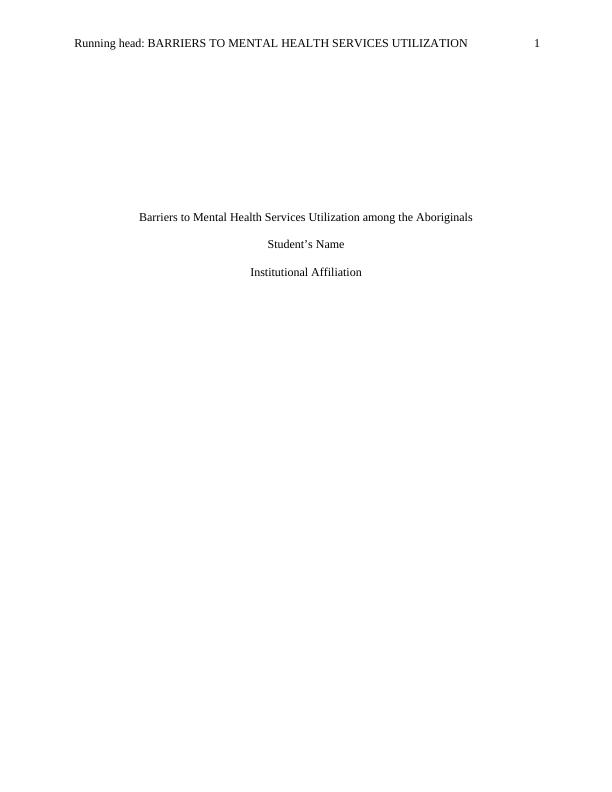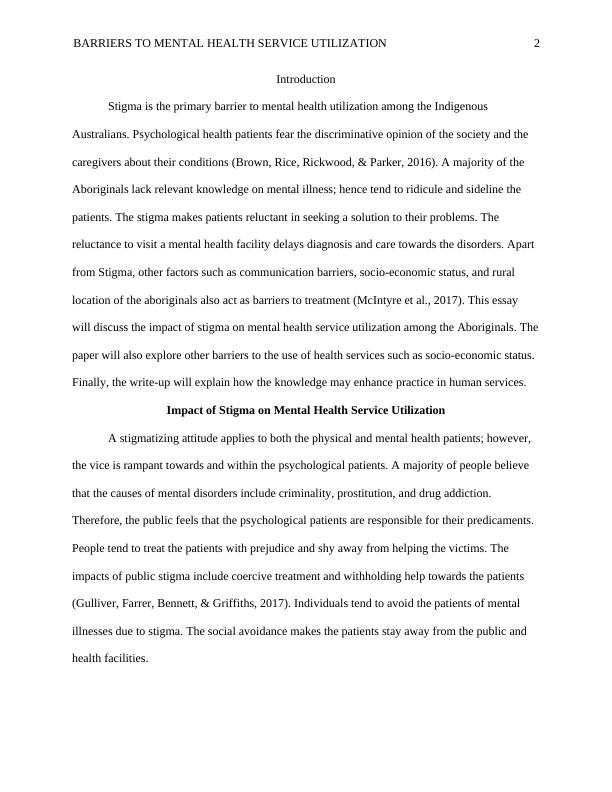Barriers to Mental Health Services Utilization among the Aboriginals
Added on 2023-06-07
9 Pages2400 Words171 Views
Running head: BARRIERS TO MENTAL HEALTH SERVICES UTILIZATION 1
Barriers to Mental Health Services Utilization among the Aboriginals
Student’s Name
Institutional Affiliation
Barriers to Mental Health Services Utilization among the Aboriginals
Student’s Name
Institutional Affiliation

BARRIERS TO MENTAL HEALTH SERVICE UTILIZATION 2
Introduction
Stigma is the primary barrier to mental health utilization among the Indigenous
Australians. Psychological health patients fear the discriminative opinion of the society and the
caregivers about their conditions (Brown, Rice, Rickwood, & Parker, 2016). A majority of the
Aboriginals lack relevant knowledge on mental illness; hence tend to ridicule and sideline the
patients. The stigma makes patients reluctant in seeking a solution to their problems. The
reluctance to visit a mental health facility delays diagnosis and care towards the disorders. Apart
from Stigma, other factors such as communication barriers, socio-economic status, and rural
location of the aboriginals also act as barriers to treatment (McIntyre et al., 2017). This essay
will discuss the impact of stigma on mental health service utilization among the Aboriginals. The
paper will also explore other barriers to the use of health services such as socio-economic status.
Finally, the write-up will explain how the knowledge may enhance practice in human services.
Impact of Stigma on Mental Health Service Utilization
A stigmatizing attitude applies to both the physical and mental health patients; however,
the vice is rampant towards and within the psychological patients. A majority of people believe
that the causes of mental disorders include criminality, prostitution, and drug addiction.
Therefore, the public feels that the psychological patients are responsible for their predicaments.
People tend to treat the patients with prejudice and shy away from helping the victims. The
impacts of public stigma include coercive treatment and withholding help towards the patients
(Gulliver, Farrer, Bennett, & Griffiths, 2017). Individuals tend to avoid the patients of mental
illnesses due to stigma. The social avoidance makes the patients stay away from the public and
health facilities.
Introduction
Stigma is the primary barrier to mental health utilization among the Indigenous
Australians. Psychological health patients fear the discriminative opinion of the society and the
caregivers about their conditions (Brown, Rice, Rickwood, & Parker, 2016). A majority of the
Aboriginals lack relevant knowledge on mental illness; hence tend to ridicule and sideline the
patients. The stigma makes patients reluctant in seeking a solution to their problems. The
reluctance to visit a mental health facility delays diagnosis and care towards the disorders. Apart
from Stigma, other factors such as communication barriers, socio-economic status, and rural
location of the aboriginals also act as barriers to treatment (McIntyre et al., 2017). This essay
will discuss the impact of stigma on mental health service utilization among the Aboriginals. The
paper will also explore other barriers to the use of health services such as socio-economic status.
Finally, the write-up will explain how the knowledge may enhance practice in human services.
Impact of Stigma on Mental Health Service Utilization
A stigmatizing attitude applies to both the physical and mental health patients; however,
the vice is rampant towards and within the psychological patients. A majority of people believe
that the causes of mental disorders include criminality, prostitution, and drug addiction.
Therefore, the public feels that the psychological patients are responsible for their predicaments.
People tend to treat the patients with prejudice and shy away from helping the victims. The
impacts of public stigma include coercive treatment and withholding help towards the patients
(Gulliver, Farrer, Bennett, & Griffiths, 2017). Individuals tend to avoid the patients of mental
illnesses due to stigma. The social avoidance makes the patients stay away from the public and
health facilities.

BARRIERS TO MENTAL HEALTH SERVICE UTILIZATION 3
Employers also shy away from recruiting individuals with mental disorders. Therefore,
the patients lack money to seek for adequate and appropriate health services. Apart from the
impacts of public stigma, self-stigma also leads to underutilization of mental health facilities.
Patients with psychological disorders feel less important in the society due to how people interact
with them (Knox et al., 2014). Public stigmatization makes the confidence and the self-esteem of
the patients to suffer. Therefore, a person with low confidence and depleted low esteem is
reluctant to seek medical attention towards the condition. The victims fear that the caregivers can
laugh at them when they visit the health facilities. Therefore, such individuals prefer to remain
indoors; thus underutilizing the mental health services.
Communication Barriers
Apart from stigma, communication barriers also lead to underutilization of the mental
health facilities. The aboriginals speak a different language from the caregivers from the other
Australian tribes. The disparity in the language interferes with communication between the
nurses and the patients (Armstrong et al., 2017). Therefore, mental health patients receive
substandard attention due to the misunderstanding between them and the care providers. The
differences in cultural values also have an impact on communication between the caregivers and
the mental health clients. The aboriginal patient may understand English, but the cultural beliefs
can limit the amount of openness towards the caregiver. An example is when a male patient
attends to a female indigenous patient. The client can be uncomfortable with the gender
difference and fear to provide all the necessary information regarding the mental disorder.
Experiences of patients in their interaction with caregivers can also hamper
communication; thus minimizing health service utilization. A patient that received harsh
feedback from a caregiver can shy away from disclosing information on the health status
Employers also shy away from recruiting individuals with mental disorders. Therefore,
the patients lack money to seek for adequate and appropriate health services. Apart from the
impacts of public stigma, self-stigma also leads to underutilization of mental health facilities.
Patients with psychological disorders feel less important in the society due to how people interact
with them (Knox et al., 2014). Public stigmatization makes the confidence and the self-esteem of
the patients to suffer. Therefore, a person with low confidence and depleted low esteem is
reluctant to seek medical attention towards the condition. The victims fear that the caregivers can
laugh at them when they visit the health facilities. Therefore, such individuals prefer to remain
indoors; thus underutilizing the mental health services.
Communication Barriers
Apart from stigma, communication barriers also lead to underutilization of the mental
health facilities. The aboriginals speak a different language from the caregivers from the other
Australian tribes. The disparity in the language interferes with communication between the
nurses and the patients (Armstrong et al., 2017). Therefore, mental health patients receive
substandard attention due to the misunderstanding between them and the care providers. The
differences in cultural values also have an impact on communication between the caregivers and
the mental health clients. The aboriginal patient may understand English, but the cultural beliefs
can limit the amount of openness towards the caregiver. An example is when a male patient
attends to a female indigenous patient. The client can be uncomfortable with the gender
difference and fear to provide all the necessary information regarding the mental disorder.
Experiences of patients in their interaction with caregivers can also hamper
communication; thus minimizing health service utilization. A patient that received harsh
feedback from a caregiver can shy away from disclosing information on the health status

End of preview
Want to access all the pages? Upload your documents or become a member.
Related Documents
Stigma: Impacts and Strategies to Reducelg...
|4
|904
|99
Impacts of Bias and Stigma within the Nursing Rolelg...
|9
|2124
|96
Education about Mental Illnesslg...
|5
|901
|189
Recovery Paradigm Mental Healthlg...
|8
|1994
|73
Biophysical and Psychosocial Processes in Dementia Patientslg...
|7
|2712
|191
Understanding Paranoid Personality Disorder (PPD)lg...
|4
|617
|38
